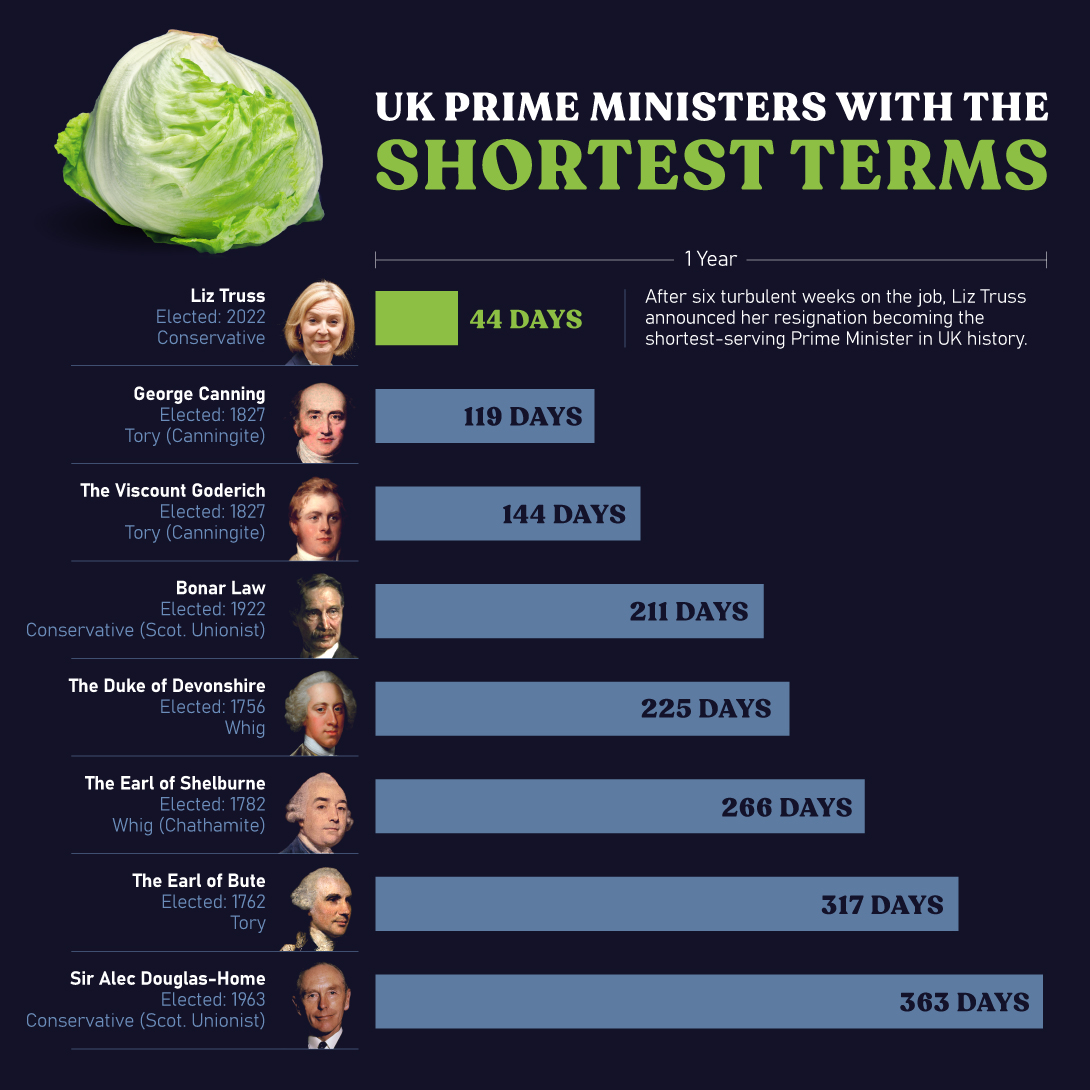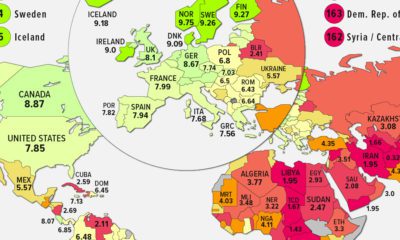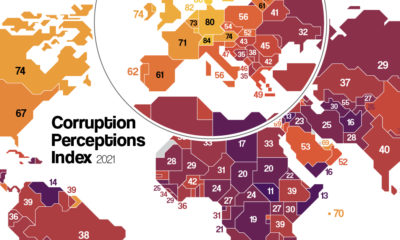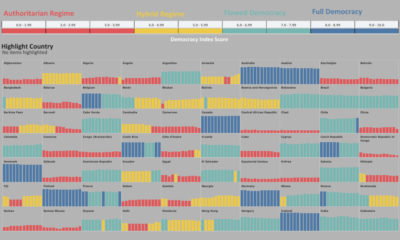Datastream
UK Prime Ministers with the Shortest Term Length
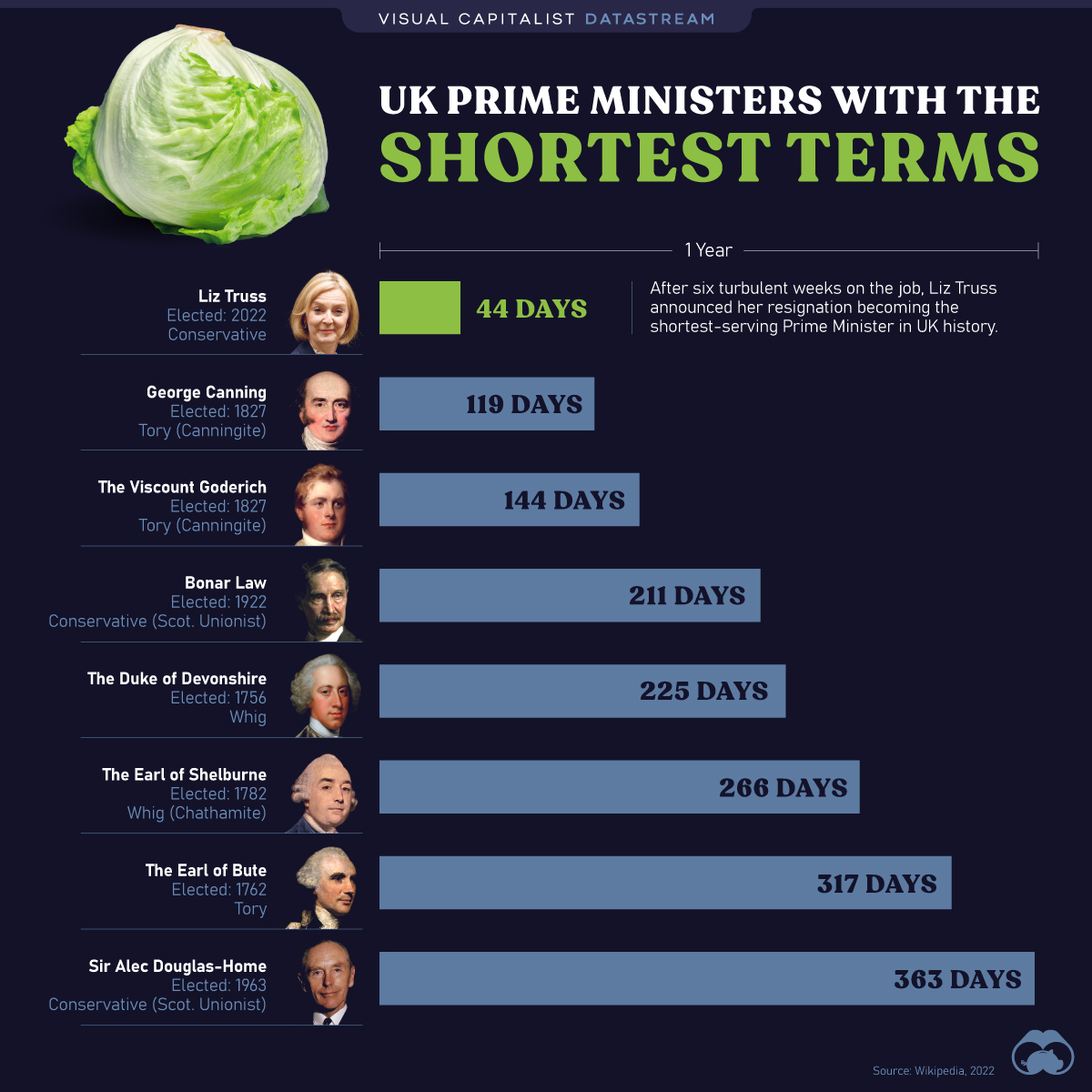
The Briefing
- Eight Prime Ministers in UK history have had terms shorter than one year
- In October 2022, Liz Truss became the shortest-serving PM, with just 44 days in the role
UK Prime Ministers with the Shortest Term Length
After six weeks that many have described as “chaotic”, UK Prime Minister Liz Truss has resigned. In stepping out of the PM role, Truss is stepping into the history books as the shortest-serving PM in UK history.
While Truss’s term is noteworthy for its briefness, she is not the only politician to have a whirlwind tour of Number 10 Downing Street. Of the 56 people who have held the PM position, eight have served less than a year:
| Prime Minister | Length of Term | Party | Start of Tenure | Reason for Exit |
|---|---|---|---|---|
| Liz Truss | 44 days | Conservative | 2022 | Resigned |
| George Canning | 119 days | Tory (Canningite) | 1827 | Died |
| F. J. Robinson, 1st Viscount Goderich | 144 days | Tory (Canningite) | 1827 | Replaced |
| Andrew Bonar Law | 211 days | Conservative (Scot. Unionist) | 1922 | Illness |
| W. Cavendish, 4th Duke of Devonshire | 225 days | Whig | 1756 | Replaced |
| W. Petty, 2nd Earl of Shelburne | 266 days | Whig (Chathamite) | 1782 | Replaced |
| J. Stuart, 3rd Earl of Bute | 317 days | Tory | 1762 | Resigned |
| Sir Alec Douglas-Home | 363 days | Conservative (Scot. Unionist) | 1963 | Election |
The next shortest term in the post-war period goes to Sir Alec Douglas-Home, who served just a hair under one year.
Why So Short?
There are a variety of reasons why leaders have served such short terms.
Much like Liz Truss’s situation, PMs like John Stuart, third Earl of Bute, and Augustus Henry Fitzroy, 3rd Duke of Grafton, ended up resigning during turbulent political situations.
Others, such as George Canning and Andrew Bonar Law, had their terms cut short after succumbing to illness. (Thankfully, this is less common in the modern era.)
Some leaders were merely keeping the seat warm until a more permanent leader stepped into the role, as was the case with William Cavendish, 4th Duke of Devonshire.
A Global Look at Brevity in Office
Of course, short tenures are not unique to the UK. Truss’s departure is drawing comparisons to Kim Campbell and John Turner, who were Canadian PMs for 132 and 72 days, respectively.
In 2007, Kevin Rudd’s second stint as Australia’s PM lasted just 83 days. Australia even has a 7 day term in its history, as Frank Forde served as PM in a caretaker capacity after the death of John Curtin in 1945.
Japan is a country that has notably short tenures in office as well. Over the past three decades, the average length of a Japanese prime minister’s tenure has been under two years.
Where does this data come from?
Source: UK.gov, via Wikipedia
Datastream
Can You Calculate Your Daily Carbon Footprint?
Discover how the average person’s carbon footprint impacts the environment and learn how carbon credits can offset your carbon footprint.

The Briefing
- A person’s carbon footprint is substantial, with activities such as food consumption creating as much as 4,500 g of CO₂ emissions daily.
- By purchasing carbon credits from Carbon Streaming Corporation, you can offset your own emissions and fund positive climate action.
Your Everyday Carbon Footprint
While many large businesses and countries have committed to net-zero goals, it is essential to acknowledge that your everyday activities also contribute to global emissions.
In this graphic, sponsored by Carbon Streaming Corporation, we will explore how the choices we make and the products we use have a profound impact on our carbon footprint.
Carbon Emissions by Activity
Here are some of the daily activities and products of the average person and their carbon footprint, according to Clever Carbon.
| Household Activities & Products | CO2 Emissions (g) |
|---|---|
| 💡 Standard Light Bulb (100 watts, four hours) | 172 g |
| 📱 Mobile Phone Use (195 minutes per day)* | 189 g |
| 👕 Washing Machine (0.63 kWh) | 275 g |
| 🔥 Electric Oven (1.56 kWh) | 675 g |
| ♨️ Tumble Dryer (2.5 kWh) | 1,000 g |
| 🧻 Toilet Roll (2 ply) | 1,300 g |
| 🚿 Hot Shower (10 mins) | 2,000 g |
| 🚙 Daily Commute (one hour, by car) | 3,360 g |
| 🍽️ Average Daily Food Consumption (three meals of 600 calories) | 4,500 g |
| *Phone use based on yearly use of 69kg per the source, Reboxed | |
Your choice of transportation plays a crucial role in determining your carbon footprint. For instance, a 15 km daily commute to work on public transport generates an average of 1,464 g of CO₂ emissions. Compared to 3,360 g—twice the volume for a journey the same length by car.
By opting for more sustainable modes of transport, such as cycling, walking, or public transportation, you can significantly reduce your carbon footprint.
Addressing Your Carbon Footprint
One way to compensate for your emissions is by purchasing high-quality carbon credits.
Carbon credits are used to help fund projects that avoid, reduce or remove CO₂ emissions. This includes nature-based solutions such as reforestation and improved forest management, or technology-based solutions such as the production of biochar and carbon capture and storage (CCS).
While carbon credits offer a potential solution for individuals to help reduce global emissions, public awareness remains a significant challenge. A BCG-Patch survey revealed that only 34% of U.S. consumers are familiar with carbon credits, and only 3% have purchased them in the past.
About Carbon Streaming
By financing the creation or expansion of carbon projects, Carbon Streaming Corporation secures the rights to future carbon credits generated by these sustainable projects. You can then purchase these carbon credits to help fund climate solutions around the world and compensate for your own emissions.
Ready to get involved?
>> Learn more about purchasing carbon credits at Carbon Streaming
-

 Green2 weeks ago
Green2 weeks agoRanked: Top Countries by Total Forest Loss Since 2001
-

 Travel1 week ago
Travel1 week agoRanked: The World’s Top Flight Routes, by Revenue
-

 Technology1 week ago
Technology1 week agoRanked: Semiconductor Companies by Industry Revenue Share
-

 Money2 weeks ago
Money2 weeks agoWhich States Have the Highest Minimum Wage in America?
-

 Real Estate2 weeks ago
Real Estate2 weeks agoRanked: The Most Valuable Housing Markets in America
-

 Markets2 weeks ago
Markets2 weeks agoCharted: Big Four Market Share by S&P 500 Audits
-

 AI2 weeks ago
AI2 weeks agoThe Stock Performance of U.S. Chipmakers So Far in 2024
-

 Automotive2 weeks ago
Automotive2 weeks agoAlmost Every EV Stock is Down After Q1 2024

